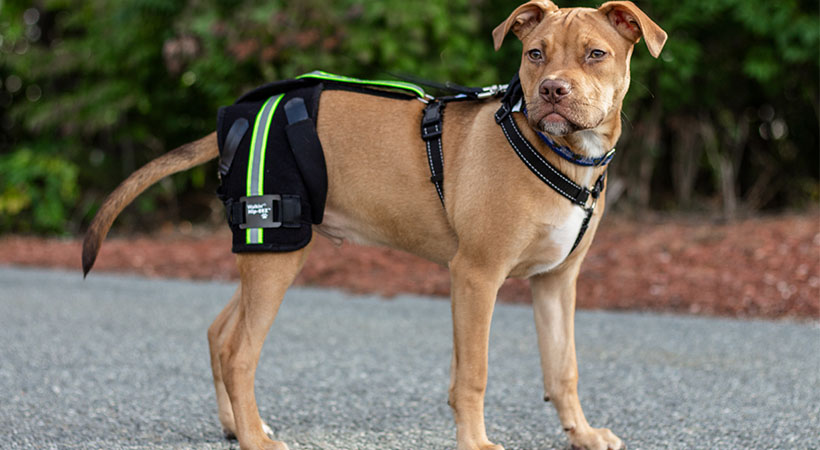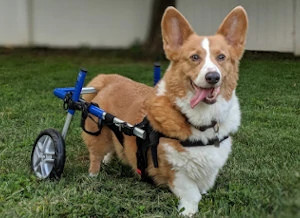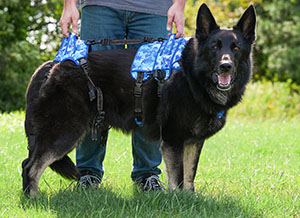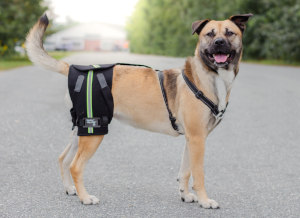A typical fear for anybody with a big breed canine is hip dysplasia. You’ve heard about it from pals, household, and all-over social media for years. These two phrases have struck worry in canine homeowners for years! However how a lot of the data you hear is actual, and the way a lot is predicated on an exaggerated worry? For instance, do you know a canine with hip dysplasia can nonetheless stay a full and joyful life? By itself, hip dysplasia just isn’t a loss of life sentence, and with the appropriate care and therapy, it may be managed.
What’s Canine Hip Dysplasia?

Canine Hip dysplasia is a developmental dysfunction that happens when the hip joint doesn’t type correctly throughout development. Both the femur or acetabulum is misshapen, and in some circumstances each are.
The hip joint is a ball-and-socket joint, the top of the femur being the ball and the acetabulum being the socket. When one, or each, are malformed or misaligned the joint doesn’t transfer easily which might trigger the canine ache or impede their vary of motion. In some circumstances, the femur can really slip out of the acetabulum and bang round.
In any case, canines with hip dysplasia have a hip joint that’s unstable and liable to extra put on and tear.
Causes of Hip Dysplasia in Canine
The precise reason behind hip dysplasia just isn’t absolutely understood, however it’s believed to be influenced by each genetic and environmental components. A number of the potential causes are:
- Genetic predisposition
- Breed-specific incidence
- Fast development
- Diet
- Train
Early Indicators of Malformed Hips

Hip dysplasia is commonly current at start however may develop when the pet is younger and nonetheless rising. By the point they’re two years outdated any deformity within the hip joint will already be current.
A canine with hip dysplasia could not expertise any issues or ache till later in life, however there are some indicators to look out for.
- Problem getting up or laying down
- Diminished want to run, bounce, or play
- Limping or favoring one hind leg
- Swelling or ache across the hips
- Stiff or decreased vary of movement within the hips
- Slender stance or bunny hopping (shifting each hind legs collectively)
- Grating or clicking sound coming from the hips
Can Hip Dysplasia Kill my Canine?
One of many very first questions canine homeowners ask when their canine is recognized with hip dysplasia is: Can hip dysplasia kill my canine? The straightforward reply isn’t any, hip dysplasia by itself just isn’t deadly.
The extra sophisticated reply is that whereas not being deadly, hip dysplasia does trigger continual ache, restricted motion, and different problems that may have an effect on your canine’s high quality of life and lifespan, particularly if untreated.
Issues from Hip Dysplasia
Arthritis is without doubt one of the commonest problems canines with hip dysplasia have. It happens when the cartilage within the joint has worn away which causes bone-on-bone contact. The result’s typically ache, stiffness, swelling, decreased vary of movement, and lack of joint operate.
Different potential problems are:
- Osteoarthritis
- Avascular Necrosis (extra frequent in small breeds with hip dysplasia)
- Hip Luxation
Any complication from hip dysplasia can negatively have an effect on your canine’s well being and high quality of life.
High quality of Life
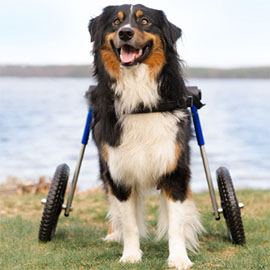
Your canine’s high quality of life relies on many components, together with, the dysplastic severity, the therapy choices, response to the therapy, care at dwelling, and the person persona of your canine.
Some canines can have gentle signs stopping them from leaping on the mattress, however not limiting their life in every other manner. Canine with extra extreme signs might have issues standing as much as go the lavatory or eat.
There is no such thing as a one option to measure high quality of life. You’ll be able to depend on scales, such because the Canine Transient Ache Stock (CBPI) or the Canine High quality of Life Scale (CQLS), however finally it comes right down to proprietor notion.
Do you see your canine struggling to face lengthy sufficient to eat, can they do the issues they need to do with relative ease, and most significantly, are they joyful?
How Lengthy Can a Canine Dwell with Hip Dysplasia?
Identical to high quality of life, there is no such thing as a one dimension matches all reply to how lengthy a canine can stay. Many canines stay a standard or near-normal life with hip dysplasia, whereas others can endure a shorter lifespan.
There are a lot of components to think about, a few of them are:
- Age of Onset
- Situation Development
- Accessible Therapies
- Response to Therapies
- Presence and Severity of Issues
- High quality of life
These components fluctuate from canine to canine and might change all through the canine’s life as properly. Working together with your veterinarian and realizing about issues forward of time could make an enormous distinction. For instance, early screening at 2 years outdated might present that your canine has hip dysplasia. Even when they haven’t any ache and present no signs but, realizing about it early offers you time to take measures to maintain them wholesome and probably forestall any main issues.
Recognizing Hip Dysplasia in Your Canine
In case you’ve observed your canine exhibiting any of those indicators it’s a good suggestion to seek the advice of your veterinarian. They’ll be capable of verify whether or not your canine has hip dysplasia and, in the event that they do, to what diploma.
Whereas x-rays are the one definitive check for hip dysplasia, the strategies of analysis are totally different. The 2 main analysis strategies are the Orthopedic Basis for Animals (OFA) Hip Analysis and the PennHIP Analysis.
Some key variations between the 2 are:
OFA Hip Analysis: Canine 2 years and older may be evaluated and any veterinarian with an x-ray machine can ship photos off for certification.
PennHIP Analysis: Can be utilized on canines as younger as 16 weeks and might precisely predict future hip adjustments. The draw back is it might solely be carried out by vets which have undergone PennHIP certification and canines should be sedated to get correct laxity measurements.
Canine Breeds Extra Liable to Hip Dysplasia
As we’ve talked about, some canine breeds have a better probability of being born with or growing hip dysplasia than others. In keeping with the OFA statistics, some breeds with the best proportion of hip dysplasia are:
- Pug: 71.7%
- Bulldog: 70.1%
- Dogue de Bordeaux: 57.1%
- Otterhound: 47.2%
- Clumber Spaniel: 40.7%
And a few breeds with the bottom proportion of hip dysplasia are:
- Italian Greyhound: 0.2%
- Portuguese Podengo Pequeno: 1.2%
- Manchester Terrier: 1.4%
- Ibizan Hound: 1.5%
- Saluki: 1.7%
Dr. Daisy A. Could, MRCVS BVSc, a contributor to All About Parrots, has some fascinating perception about canine breeds and hip dysplasia.
“Concerning breeds and their threat, it’s not a black and white story; it’s extra like a posh genetic puzzle. True, you’ll see it extra in your German Shepherds and Labradors, however a mutt with the mistaken genetic hand can endure too.”
Dr. Could provides “By way of small canines with severe hip points, they’re the exception fairly than the rule in my observe. Positive, I’ve seen a Chihuahua waddle in with the identical drawback that plagues some Saint Bernard. However typically, the dimensions ideas in favor of the large guys.”
Hip Dysplasia Therapy Choices
Whereas there is no such thing as a remedy for hip dysplasia, there are therapy choices that may assist handle the situation and enhance your canines high quality of life. The choice with the perfect probability of success will rely in your canines age, weight, dysplastic severity, and the signs your canine already reveals.
Non-Surgical Choices
Sometimes, non-surgical therapy choices are really useful for gentle – reasonable circumstances or when canines will not be good candidates for surgical procedure. Non-surgical therapy choices are:
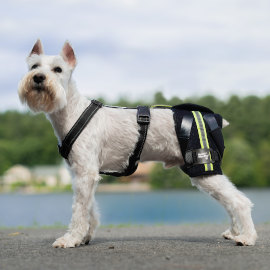
- Treatment: Anti-inflammatory medication, reminiscent of nonsteroidal anti-inflammatory medication (NSAIDs) or corticosteroids, might help scale back ache and irritation within the hip joint.
- Dietary supplements: Dietary dietary supplements like glucosamine, chondroitin, omega-3 fatty acids, or green-lipped mussel extract, might help help joint well being and cartilage restore.
- Bodily remedy: Bodily remedy might help strengthen the muscle tissues across the hip joint and enhance its vary of movement and performance. Bodily remedy could embody workout routines, therapeutic massage, hydrotherapy, acupuncture, laser remedy, or electrical stimulation.
- Weight administration: Weight administration is essential for canines with hip dysplasia, as extra weight can put extra stress on the joint and worsen the situation. A nutritious diet and reasonable train might help your canine keep a super weight and stop weight problems.
Hip Dysplasia Surgical procedure
Surgical procedure is often really useful in additional extreme circumstances or after a canine has proven to not do properly with non-surgical choices. Surgical procedure can restore stability in addition to operate to the hip joint and relieve ache. However it’s not with out dangers. An infection, bleeding, nerve harm, and implant failure are among the many dangers of surgical procedure.
- Triple pelvic osteotomy (TPO): This process includes chopping and rotating the pelvic bone to enhance the alignment and match of the ball and socket. TPO’s can forestall additional degeneration and protect the pure joint.
- Femoral head ostectomy (FHO): This process includes eradicating the top of the femur (the ball) to eradicate bone-on-bone contact and create a false joint. An FHO process might help scale back ache and enhance mobility.
- Whole hip alternative (THR): Just like the identify suggests, a THR includes changing each the ball and socket with synthetic implants manufactured from metallic and plastic. This might help restore regular operate and motion of the joint.
When requested in regards to the success charges, Dr. Kathryn Rosalie Dench, a veterinary surgeon, and author at GentleDog Trainers mentioned “THR provides the perfect long-term outcomes for extreme hip dysplasia however is a extra complicated and dear process. Success charges are typically excessive, with canines regaining near-normal operate.”
Dwelling Look after Canine with Hip Dysplasia
There are extra methods you may assist your canine address hip dysplasia, whether or not you went the surgical route or not. Offering your canine with simpler methods to get round and be comfy will improve their happiness, well-being, and mobility. A couple of good concepts are:
- Snug bedding: A cushty and supportive mattress might help your canine relaxation and sleep higher. Orthopedic beds, reminiscence foam beds, heated beds, or elevated beds can cushion your canine’s hips and joints and hold them heat and comfortable.
- Ramps and stairs: Utilizing ramps and stairs might help your canine transfer round with out having to leap or climb, which might rapidly worsen their hip dysplasia.
- Harnesses and slings: Utilizing specifically designed harnesses and slings might help you help your canine’s weight and mobility once they stroll, stand, or go up and down stairs.
- Therapeutic massage and grooming: Massages and brushing might help your canine enhance their blood circulation, scale back muscle pressure, and relieve ache and stiffness of their hips and joints.
- Environmental enrichment: Preserve your canine joyful and engaged with toys, puzzles, video games, treats, and social interactions to counterpoint your canine’s surroundings and supply them psychological and bodily challenges which can be appropriate for his or her situation.

Visitor Creator:
Chase Roseberry
Chase Roseberry has spent his life surrounded by all types of animals. From rising up with horses, canines, and cats to preserving a number of saltwater aquariums, he rapidly realized he loves all animals. He now shares his ardour by writing on BuzzPetz along with his loyal German Shepherd proofreading at his facet. You will get in contact with Chase on LinkedIn.
Associated Articles:


